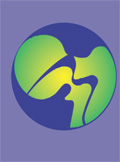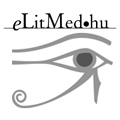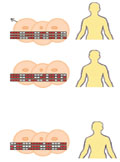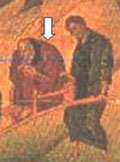The eLitMed.hu medical portal uses computer cookies for convenient operation. Detailed information can be found in the Cookie-policy.
LAM KID - 2012;2(03)
Content
[Efficiency of osteoporosis treatment in Hungary - An analysis of the Hungarian National Insurance Company’s data]
[The treatment of osteoporosis and its consequences place a significant burden on the health care of developed countries. Modern therapeutical approaches are able to efficiently decrease the risk of osteoporotic bone fractures. However, we do not know whether the interventions introduced in the past 15 years have significantly reduced the number of osteoporotic fractures in real life, and if they have, how cost-effective this effect was. To answer these questions, we have analysed data of the Hungarian National Insurance Company collected between 2004-2010. During these 7 years, the number of bone fractures among patients treated for osteoporosis continuously decreased. This was also observed in the incidence of hip fractures. Interestingly, the mortality of osteoporotic patients was significantly lower than that of the same age group in the average population. Besides the efficient treatment of osteoporosis, this finding is also due to the outstanding general care provided by the specialised osteoporosis centers of the country. As a consequence of the reduction in fractures, 3.4 billion HUF was saved per year by the insurance company, which is approximately equal to the 3.5 billion HUF spent on the reimbursement of medicines used for the treatment of osteoporosis, which means that the investments show a return. The calculation of the quality- adjusted life years, which is the internationally accepted method of the WHO for the study of cost-effectiveness, shows that the above results were achieved in a remarkably cost-efficient way. At the same time, it is noteworthy and calls for caution that the decrease in reimbursement by the insurance company in 2007 resulted in a 51% drop in the number of patients receiving treatment, which radically reduced the observed efficiency.]
[The effect of nonsteroidal anti-inflammatory drugs on articular cartilage]
[In developed countries, the treatment of osteoarthritis costs up to 1-2% of the GNP. The poor hygroscopy of hyaline cartilage and of glycosaminoglycan (GAG) molecules that are components of proteoglycans plays a key role in the development of the disease. Age-related osteoarthritis mostly affects the weight-bearing joints of the lower extremities, the hips and knees, and - more frequently than the former ones - the small joints of the hands, causing chronic pain and disability. Nonsteroidal anti-inflammatory drugs (NSAIDs) used for the treatment of osteoarthritis-related pain influence not only pain but also cartilage metabolism, and - among others - GAG molecules. NSAIDs diminish the biosynthesis of prostaglandins (PG) that have a role in inflammatory processes, and influence oxygen free radicals, the levels of interleukins (ILs) and the function of metalloproteinases. The ideal NSAID for the joints stimulates cartilage formation, reduces cartilage resorption, and the level of katabolic cytokines. Aceclofenac was found to have the most beneficial effect on multiple aspects of cartilage metabolism.]
[Vitamin D deficiency and infections]
[Studies performed in the past few years have confirmed that vitamin D is essential for maintaining the optimal immune defense, and its immunomodulatory effect has a role in the defense against infections as well. A lot of data suggest that low serum 25-(OH)-D concentration is associated with an increased frequency of certain infections and it adversely influences pathological processes. Data on this adverse effect are available mostly in case of Mycobacterium tuberculosis, respiratory viral infections in general, HIV, hepatitis C and sepsis. The outcomes of severe infections are usually influenced by a number of factors and it seems that vitamin D deficiency is one of those factors that shift the process towards an unfavourable outcome. Further studies should evaluate the significance of this role and the influence of vitamin D supplementation on pathological processes.]
[Estimating the risk of new fracture - Which factors confer an increased fracture risk?]
[This risk of osteoporosis-related fractures is influenced by a number of well-known risk factors. Among the approaches to quantify bone fracture risk, the FRAX questionnaire is the most widespread in everyday practice. However, this method only provides a probability percentage for the physician, and it is unable to specify or weigh the factors that may have a particular importance in evaluating individual fracture risk, or choosing the appropriate therapy in patients with previous osteoporotic fracture. This summary aims to provide practical help for the evaluation of individual fracture risk in patients who have had bone fractures.]
[Why twins are different? - About twin research]
[Twin studies had an important role in the development of medicine. In this review, we present the available data of Hungarian twin studies and the number of twins in Hungary on the basis of statistical data. Comparing these data with international ones and taking into account probable prevalences, we aim to provide an estimation of the number of twins in Hungary who have cancerous diseases. Our estimation suggests that creation of a national database for such twins is feasible and could provide a great help for a better understanding of the causes and mechanisms of cancerous diseases.]
[Association between osteoporosis and nutrition during the history of human evolution]
[From the Palaeolithic age to the twentieth century, nutritional habits as well as the quality and composition of nutritients changed dramatically. The protein-based calorie intake of former Homo species had been replaced by a carbohydrate-based nutrition since the Neolithic revolution (the transition to agriculture). The start of food production also changed the range of nutrients and the start of sedentary lifestyle. At the same time, approximately five thousand years ago osteoporosis appeared. In this paper, the authors give a short review of eating habits and foods of early Homo species in the Palaeolithic Age and of Homo sapiens in Neolithic Age, Antiquity, Middle Ages and Modern Age, and discuss the possible relationship of nutrition and osteoporosis.]
1.
Clinical Neuroscience
[Headache registry in Szeged: Experiences regarding to migraine patients]2.
Clinical Neuroscience
[The new target population of stroke awareness campaign: Kindergarten students ]3.
Clinical Neuroscience
Is there any difference in mortality rates of atrial fibrillation detected before or after ischemic stroke?4.
Clinical Neuroscience
Factors influencing the level of stigma in Parkinson’s disease in western Turkey5.
Clinical Neuroscience
[The effects of demographic and clinical factors on the severity of poststroke aphasia]1.
2.
Clinical Oncology
[Pancreatic cancer: ESMO Clinical Practice Guideline for diagnosis, treatment and follow-up]3.
Clinical Oncology
[Pharmacovigilance landscape – Lessons from the past and opportunities for future]4.
5.









